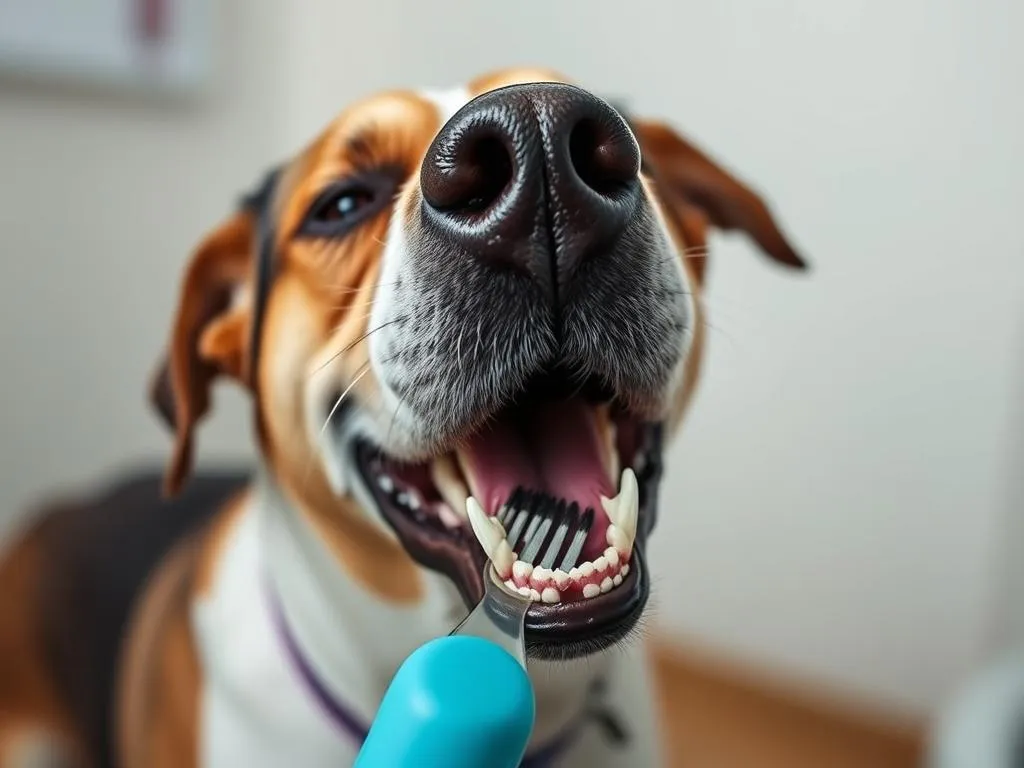
Dental care is a crucial aspect of maintaining your dog’s overall health and well-being. Just like humans, dogs are susceptible to dental diseases, which can lead to severe health complications if left untreated. A staggering 80% of dogs show signs of dental disease by the age of three. This alarming statistic highlights the significant need for proper dental hygiene in our furry companions. So, the pressing question arises: is it too late to brush dogs’ teeth?
Understanding Canine Dental Health
Anatomy of a Dog’s Mouth
A dog’s mouth is specifically designed for their dietary needs, featuring sharp teeth for tearing and grinding. Dogs typically have 42 teeth compared to humans who have 32. Their dental structure includes incisors, canines, premolars, and molars, each serving a distinct purpose in their feeding habits. The gums are also crucial in supporting teeth and protecting against infections.
In contrast to human teeth, dog teeth are more pointed and not as flat, reflecting their carnivorous diet. Additionally, dogs have a different jaw structure, which can impact their biting and chewing methods. Understanding these differences can help pet owners appreciate the importance of tailored dental care for dogs.
Common Dental Issues in Dogs
Dental issues in dogs can vary, but some of the most prevalent problems include:
- Periodontal Disease: This is the most common dental issue affecting dogs, characterized by inflammation and infection of the structures surrounding the teeth.
- Gingivitis: An early stage of periodontal disease, gingivitis presents as swollen and bleeding gums.
- Tooth Decay: Although less common in dogs than in humans, cavities can occur, particularly in older dogs.
- Bad Breath: Often a sign of underlying dental problems, persistent bad breath should not be overlooked.
Signs that your dog may be experiencing dental issues include difficulty chewing, pawing at their mouth, excessive drooling, or a noticeable change in eating habits.
The Importance of Brushing Dogs’ Teeth
Benefits of Regular Dental Care
Brushing your dog’s teeth is not just about keeping their breath fresh. Regular dental care offers numerous benefits:
- Prevention of Dental Diseases: Routine brushing helps remove plaque and tartar buildup, significantly reducing the risk of periodontal disease.
- Reduction of Bad Breath: Regular brushing can help eliminate the bacteria that cause bad breath, making your dog’s kisses more enjoyable.
- Impact on Overall Health: Poor dental health can lead to systemic issues, including heart disease, kidney disease, and infections. Maintaining good oral hygiene can help mitigate these risks.
When to Start Brushing
It’s best to introduce dental care when your dog is a puppy. The recommended age to start brushing your dog’s teeth is around six months, when their adult teeth are coming in. Early dental hygiene practices can familiarize your dog with the brushing process, making it easier as they grow older.
Is It Too Late to Brush Dogs’ Teeth?
Assessing Your Dog’s Current Dental Health
If you haven’t started brushing your dog’s teeth yet, you might wonder if it’s too late. The first step is to assess your dog’s current dental condition. Look for signs of dental issues, including:
- Red or swollen gums
- Loose or missing teeth
- Bad breath that persists despite regular cleaning
- Difficulty chewing or reluctance to eat
If your dog exhibits any of these symptoms, it may indicate a need for immediate veterinary attention. However, even if your dog shows signs of dental issues, it may still not be too late to start brushing.
Benefits of Starting Dental Care Late
Starting a dental care routine later in your dog’s life can still yield significant benefits. Many dogs experience improvements in their oral health after their owners begin brushing, even in their senior years. For example, there are numerous anecdotes from pet owners who report dramatic improvements in their dog’s breath and overall dental health after introducing a brushing routine, regardless of age.
While it may take longer to see results in older dogs, the benefits of brushing—such as reducing plaque buildup and preventing further dental disease—are still present.
How to Brush Your Dog’s Teeth
Tools and Products Needed
Before you begin brushing your dog’s teeth, it’s essential to have the right tools:
- Dog Toothbrush: Look for a toothbrush specifically designed for dogs, which usually has softer bristles and a angled head.
- Dog Toothpaste: Never use human toothpaste. Instead, opt for toothpaste made for dogs, which comes in flavors they enjoy, like poultry or peanut butter.
- Dental Chews and Treats: These can complement your brushing routine by helping to clean teeth naturally.
Step-by-Step Guide to Brushing
Brushing your dog’s teeth doesn’t have to be a daunting task. Follow these steps to create a positive experience:
-
Prepare Your Dog: Get your dog comfortable with the process by letting them sniff the toothbrush and toothpaste. Praise them and offer treats to create a positive association.
-
Positioning: Have your dog sit or lie down in a comfortable position. You may want to sit beside them or gently hold their head steady.
-
Applying Toothpaste: Put a small amount of dog toothpaste on the toothbrush.
-
Brushing Technique: Start by brushing the outer surfaces of the teeth using gentle circular motions. Focus on the back teeth where plaque typically builds up. Avoid brushing the insides of the teeth, as dogs’ tongues naturally help clean this area.
-
Reward and Praise: After brushing, reward your dog with praise or treats. This will help them associate brushing with positive experiences.
Tips for Making the Process Easier
- Start slowly and gradually increase the brushing duration to avoid overwhelming your dog.
- If your dog resists brushing, try using a finger brush or a piece of gauze wrapped around your finger to get them accustomed to the sensation.
- Be patient and consistent; over time, your dog will likely get used to the routine.
Alternatives to Brushing
Dental Chews and Treats
If brushing is not feasible, dental chews and treats can be valuable alternatives. Many products on the market are specifically formulated to help clean teeth and freshen breath. Look for options approved by the Veterinary Oral Health Council (VOHC) to ensure effectiveness.
Professional Dental Cleanings
Regular veterinary dental check-ups are essential for maintaining your dog’s oral health. Professional cleanings can remove tartar and plaque that brushing may miss. During these cleanings, your veterinarian can also identify any potential dental issues early on. Expect your vet to perform a thorough examination, which may include X-rays to assess the health of the teeth and gums.
Other Dental Health Practices
In addition to brushing and professional cleanings, consider incorporating other dental health practices into your dog’s routine:
- Dental Water Additives: These can be added to your dog’s drinking water to help reduce plaque and tartar buildup.
- Impact of Diet: A well-balanced diet plays a significant role in your dog’s dental health. Consult with your veterinarian about the best food options that promote oral health.
Maintaining Long-Term Dental Health
Establishing a Routine
Creating a consistent dental care routine is critical for long-term success. Aim to brush your dog’s teeth at least two to three times a week. Set reminders or create a schedule to ensure you stay on track. Integrate dental check-ups into your regular veterinary visits for optimal results.
Monitoring Changes in Dental Health
Keep an eye on your dog’s dental health and watch for any changes. Signs to monitor include:
- Changes in eating habits
- Increased bad breath
- Swollen gums or loose teeth
If you notice any of these signs, contact your veterinarian promptly. Regular vet visits are essential for monitoring dental health and addressing any issues before they become severe.
Conclusion
Maintaining your dog’s dental health is a vital aspect of their overall well-being. While it may seem daunting if you haven’t started yet, remember that it’s never too late to brush dogs’ teeth. With patience and the right approach, you can significantly improve your dog’s oral health and ensure they live a long, happy life. Prioritizing dental care is a loving responsibility that every pet owner should embrace.
Consider your dog’s dental health as an integral part of their overall care routine, and take the necessary steps today!









